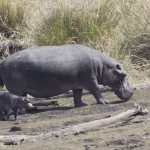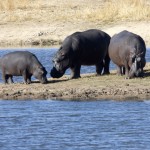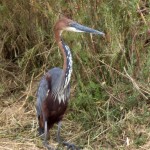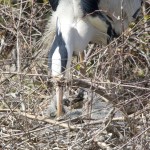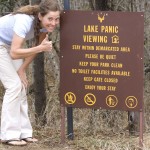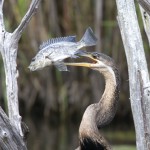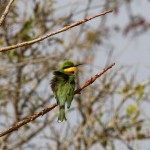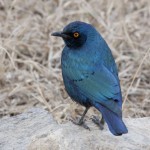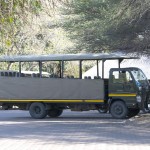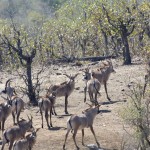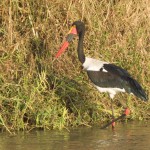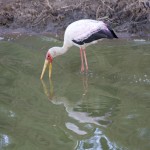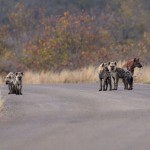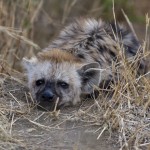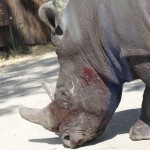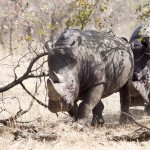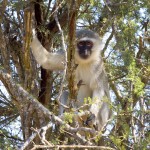The second camp was at Pretoriuskop and in that area we saw hippos for the first time. We were at Mestel Lake and the early morning sun was beautiful on the rocks. We stayed there quite a while watching the different animals come and go and finally those “weird-looking” rocks rose up and walked out onto dry land! Watching hippos is like watching paint dry. They move very ponderously, tire quickly and soon lay down or head back to the water to get the weight off their feet. It’s hard to believe that they can move fast enough to be one of the most dangerous animals in Africa.
The only “car incident” we had on the whole trip (not counting the initial entry into traffic back in Johannesburg), was at Mestel Lake. We had the inverter on for awhile to charge the camera batteries, but the biggest culprit was the headlights that got left on. So when we got ready to move – dead battery. With help we pushed the car up the incline towards the road and when we could push no further, put it in gear and coasted back down. A time to be glad that it was stick shift – it started right up and we went merrily on our way.
When we left Pretoriuskop and headed towards the next camp we had an interesting stop at Albasini ruins (where you could get out of the car), saw more hippos at the Nyamundwa watering hole, drove through Skukuza where there was a picnic area and on to a very special place which isn’t even noted in the guide, the Lake Panic Hide.
In several locations, usually along rivers, a blind was erected and after reading all the usual warning signs “you may alight from your vehicle at your own risk,” “no alcohol on these premises,” “do not leave the designated area,” and “do not talk!” we made our way into the little shelter, called a “hide.” What a pleasant surprise that was! A long bench was across one side and one end where a people could sit and prop a camera or binoculars on a ledge and watch the activity. In this case, the structure was actually built out over the waters of Lake Panic (have no idea how it got that name), which was lush and host to many birds, crocodiles, antelopes and whoever else might come to enjoy the water. Only 20 feet away we watched a Grey Heron in her nest with chicks, while her mate was fishing nearby. A crocodile swam by below us, just 3’ from the hide. Antelope came in on the shores to drink and eat the abundant green grass and a Goliath Heron fished at the far end of the lake. In addition, a flock of white-faced ducks
shared the shore with a dozing crocodile and numerous, beautifully-colored little song birds flitted in and out of the grasses.
The biggest treat of all, however, was the African Darter. This is a large bird with a long beak, who dives for fish, but he doesn’t “catch” a fish in his beak like others do. Instead, he spears them. So he comes out of the water with a 6-8” fish stuck on his beak and then must spend several minutes flipping his head this way and that trying to dislodge it. On the final and successful toss, he deftly catches the fish and immediately starts swallowing it, head-first and whole. This process also takes a minute or so and it is easy to see the bulging in the long, narrow neck as the fish makes its way to the stomach. But wait – there’s more! The final step in the dinner process is drying the wings. This bird is not equipped for diving – that is, it doesn’t have the proper oils, etc. on the feathers to keep it from getting water-logged. So the next half hour or more is spent sitting on a log or branch that is in the water with the wings held straight out to dry. Reminds me of those old commercials where women did crazy things to make their deodorant dry faster. Because of this delightful experience we stopped at every hide we came across and all were a disappointment after Lake Panic.
We hated to leave the lake, but time was flying and we had a ways to go yet to Satara. I was particularly excited to get there because it was known as the “Cat Camp” – referring to lions and other big cats. Lions were #1 on my wish list and I was salivating at the prospect of seeing whole prides with playful cubs, patient mothers and kingly fathers. So far we hadn’t seen cats of any kind, but we were racking up an impressive number of other animals including giraffes, elephants, zebras, wildebeests, wild dogs, hyenas, baboons, monkeys, mongoose, turtles, crocodiles, hippos, wart hogs, buffalo and several different kinds of antelope, of which the little impala is the most common; and too many birds to mention, including big birds such as the ostrich, hornbills, storks and herons.
Stemming from the great safari hunting days, some animals got on a list referred to as the “Big Five.” The first night in the park our excited neighbor told us he had seen all Big Five on the drive down that day. But by the time we arrived in Satara five days later we had still only seen two of the five: the elephant and the buffalo. I was more than ready to see lions and rhinos but didn’t have any real expectations of seeing leopards since they are solitary and secretive and not found in large numbers.
We put a lot of miles on the car in that area and didn’t see any kind of cat. Still hoping, I signed us up for a night drive with one of the Rangers. They
have safari vehicles that are open on both sides and four of the riders shine hand-held spot lights around in the dark hoping to catch a glimpse of something. It was quite cold and we were happy they provided blankets as our four layers of summer clothes weren’t very effective. We actually did see some wildlife, but it wasn’t that exciting because, in my book, if you don’t come away with a good picture – it wasn’t a good spotting. We saw some lions slinking away through the tall grass, a couple owls and an African Civet. Most interesting was the giraffe that was sitting on its haunches. The Ranger explained that they lay down to sleep only in captivity where they feel safe. In the wild they rest all night on their haunches because it takes a full 15 seconds for one to get to his feet from a laying down position and by that time a pride of lions would have finished him off. All the spotlights were trained on the giraffe for a full five minutes during this explanation, but for some unknown reason I didn’t even attempt to take a picture – which now, of course, I greatly regret. The other highlight of the trip was a gorgeous shooting star – no picture of that either, but the
memory is a very happy one.
- The next day we finally did see (with the help of spotters in another car) a lioness taking a nap. She was some distance away and one had to jockey for a position where she wasn’t half covered with brush. We chatted a bit with the people who had seen her come there and this is the story they told. They saw a herd of Rhone Antelope and were so pleased because they are quite rare. While they were watching the antelope, this single lioness appeared and launched an attack. She was successful in getting one down, but during the struggle the antelope managed to get to its feet and run away. Rhone Antelope have a reputation of being aggressive fighters and that one certainly proved that true and came away with his life. Other folks did spot him later during the day and said he looked and acted as if he were severely injured; so perhaps he didn’t survive. Anyway, the two were able to keep the lioness in sight and followed her to that spot where she lay down to rest. We stayed there for three hours watching her sleep. Since we knew she had missed out on a meal, we thought surely she would get up and hunt again. We saw the herd of Rhone Antelope – they were not far away and we were convinced that she would not give up. But after three hours, we finally did. You know how many hours a day a house cat sleeps? We should have known better.
When we finally left the lioness we saw other cars stopped and discovered they were watching a pride of lions. This group was even further away and in even thicker brush. The best picture I got out of that attempt was one blurry little cub. Disappointed, we moved on.
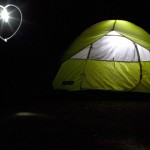 That night we stayed in a safari tent at Letaba because we hadn’t been able to get reservations for a campsite. The cost of pitching a tent averaged out to about $21/night (for both of us); the cost of a permanent safari tent averaged $54 and the stay in a regular guest hut was around $100/night. It’s easy to see why we opted for our own tent. But the Safari tent was a pleasant experience. Lydia, being tall, appreciated being able to stand up while getting ready for bed. The tents had straight walls 8’ high, board floors, two bunks with bedding, a wardrobe and a small refrigerator. The tents were up off the ground about 4’ – water can be a problem there in the rainy season.
That night we stayed in a safari tent at Letaba because we hadn’t been able to get reservations for a campsite. The cost of pitching a tent averaged out to about $21/night (for both of us); the cost of a permanent safari tent averaged $54 and the stay in a regular guest hut was around $100/night. It’s easy to see why we opted for our own tent. But the Safari tent was a pleasant experience. Lydia, being tall, appreciated being able to stand up while getting ready for bed. The tents had straight walls 8’ high, board floors, two bunks with bedding, a wardrobe and a small refrigerator. The tents were up off the ground about 4’ – water can be a problem there in the rainy season.
The next morning we decided to do chores instead of being out the gate by 6:00 am. So Lydia repacked, I did laundry and some strolling through the grounds. When we got ready to leave about 8 we stopped to gas up and found there was no electricity. So we checked out the elephant museum and wandered around taking pictures for an hour or so. We asked the attendant if they would have the same problem with electricity at Olifants – a camp about 30 miles away. He was sure they wouldn’t so we took a last look at the gauge sitting perilously close to the “E” and decided to make a run for it. God looked on us kindly and we made it there, only to find out they had no electricity either. It turns out that a couple rhinos had decided to take down a major power pole. Electricity was predicted to be back on by noon. So again we strolled, took pictures, ate lunch and waited.
Next stop: Tsendze Rustic Camp. Very strict rules about no noise applied in this rest camp. We had to go to Mopani to register and still get to the camp by 6:00 so that coupled with the late start really shortened our viewing time that day. But we enjoyed walking around at Mopani and learned that it was named after the tree which is prolific in this area. The leaves are shaped like butterflies and that’s what “Mopani” means – butterfly. Tsendze is called a rustic camp because it has no electricity. There is a communal kitchen and restrooms to which limited electricity arrives via solar panels. The camp is completely dark after 6:00 pm with no light poles, and any kind of generator or other noise-maker being forbidden. After we had worked together to barbeque our dinner (the extra two hands were needed to hold the flashlight), we were faced with a long evening in total blackness. Lydia noticed how really magnificent the stars were and lamented that she didn’t know how to take time exposures. Although I knew we wouldn’t be able to use a tripod taking pictures of the wildlife from the car, I had packed a lightweight one anyway, and now was the time to use it. The stars occupied us for awhile then we had a lesson on light painting. It’s simple, but takes a little practice to achieve the desired results. While the lens is open on the camera, someone with a flashlight “brushes” light on chosen objects. After that, Lydia stood beside the tent and “drew” a heart with the flashlight for the picture you see here. Afterwards we sat in the car for awhile intending to run the engine while we plugged in the inverter to download our pictures and make sure batteries were charged and ready for the next day. We weren’t more than five minutes into this task when we heard a little tap on the window. There was the camp manager wagging his finger in our face and telling us to turn off the engine – no noise allowed! I was really hoping in this primitive area to see some wildlife and took a walk around the fence line, but didn’t see or hear anything.
As usual, we were out the gate right at 6:00 am and less than a mile away were astonished to see a hyena family strolling down the middle of the road. The large, brownish one is the mama and she is accompanied by five “teenagers.” They were fun to watch and didn’t invoke all the nasty images that they portray in wildlife documentaries, although I’m sure they played the part to the hilt when called upon. They were coming straight for us, zig zagging as they stopped to investigate every odor that came to their noses much as a dog would. All this changing of position and direction made it difficult to take pictures for they kept getting in the “no shoot” zones of the rearview mirror or the slanted front window. We later saw a lone hyena drinking at a river. But the best hyena spotting was puppies right beside the road. The mother had chosen to rear her family in a culvert and now the little ones were old enough to come out and play. They would disappear and then be seen peeking out the other end. There was one little guy who lay quietly in the grass beside the road and let all passersby stop and take his picture. This is one of my favorite shots from the whole trip.
After the second night in Tsendze, we continued our northward trek and soon came across another hide, Nyawuti. We were reluctant to pass any by, hoping that each one would be a “Lake Panic” repeat and not just another dried up river. Some of those places must be fantastic during the rainy season, but they didn’t have much to offer us. Lydia got out of the car and went in to see if there was anything worthy of having its picture taken. I stood by the passenger door, sweeping out bread crumbs (one of the joys of eating in the car!) and getting camera equipment sorted and more orderly. When I finished, Lydia hadn’t returned so I went in to see what was happening. She replied that she was watching a kingfisher which we hadn’t seen before. I went back to the car to get the big lens and just as I got to the door, there was a terrible commotion in the brush by the road that led into the hide. Still standing beside the car, holding my camera with the 70-200mm lens on it, I waited, hoping to catch a glimpse of the action.
Suddenly two white rhinos burst into the open. The larger one had the smaller on the run now and the little guy had decided that the safest place was the parking area of the hide. So straight towards me he came with the big guy in hot pursuit. Lydia had heard the noise and started to come and check it out, but saw the rhinos headed straight for the car and decided to stay inside the hide. She managed to climb up on the 2 x 4s to which the vertical poles were nailed – forming the wall around the hide. I was still outside the car, doing what any photographer would do – taking pictures.
As they were rapidly getting closer, she called in a voice that was part panic and part commanding “Mama! Get in the car!” Reluctantly, I obeyed and immediately regretted it. The victorious rhino, having made his point, decided to leave. The defeated guy was right next to the car on the driver’s side watching his tormentor depart. Not that I would have, but I could have reached out and touched him. He was breathing heavily, bleeding and obviously under a lot of stress. As soon as the victor was out of sight, he turned around and faced the hide, still standing very close. I assumed I wouldn’t have any more success taking pictures through the side glass then the front, but I was desperate. Lydia had the keys in her pocket and I couldn’t roll the windows down. I kept tumbling from the front seat to the back wishing I could take pictures. Finally, I did the only thing I could do, take them through the glass. After a couple minutes he walked over to the hide and stood right in front of Lydia. She was motioning frantically to me, from her precarious perch on the 2 x 4s, but it didn’t occur to me what she wanted; a picture of her with the rhino. I was sorry I was too thick-headed to understand her gestures, but in retrospect, I couldn’t have taken the picture because it would have been through the front window and it wouldn’t have been good.
After the rhino was breathing more easily and he was sure the bully was gone, he trotted back across the road and disappeared in the brush. So our only rhino spotting was truly an spectacular one. Just as he was leaving, a car was driving in and saw him. We excitedly told them the story (in spite of all the signs that said “no talking”) and every time we saw them after that they referred to us as “the Rhino ladies.”
As I thought about this incident and remembered how frustrated I had been feeling so caged in the car, I thought that after all, God probably knew what He was doing. Rhinos have notoriously poor eyesight and notoriously short fuses. If I had been able to roll down a window, the sudden little electrical hum right in the ear of this already stressed-out behemoth, might have caused him to attack the car. Trust me, our car was no match for a rhino – even a defeated one!
A couple days later I remembered my frustration about the lions and the prayer that I had sent heavenward. “OK, God, you are in control of the animals – remember how you sent them to Noah to get on the Ark? We obviously aren’t having much success in going to them, so please send them to us!” I was thinking “lion” but didn’t actually say that. It dawned on me that I prayed that as I was going to sleep – and it was the very next day that God did exactly what I had asked…sent the rhinos right to us! There are a couple lessons to be learned here: 1) be careful what you pray for; and 2) pray specifically!
- Vervet Monkey
Next chapter: the fun continues!

